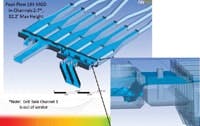About the author: Carl Seifried is senior project manager for Burgess & Niple. Michael Showalter and Mark Goodin are CFD consulting engineers for SimuTech Group. Seifried can be reached at [email protected]. Showalter can be reached at [email protected]. Goodin can be reached at [email protected].
Carl Seifried, Michael Showalter & Mark Goodin
undefinedThe Southerly Wastewater Treatment Plant (WWTP) is the largest of three wastewater treatment facilities serving the Cleveland, Ohio, metropolitan area. The plant cleans wastewater collected from homes and businesses and safely returns the water to local lakes and rivers. Solids removal is done in two stages: mechanical separation for removing larger solids and biological processes for removing the remaining smaller solids.
In 2011, civil engineering firm Burgess & Niple (B&N) entered into a contract with the Northeast Ohio Regional Sewer District for a proposed upgrade of the Southerly WWTP preliminary treatment facilities, including an improved grit removal system. To evaluate the impact of the proposed grit tank modifications on removing the desired level of particulates under both nominal and peak flow conditions, B&N turned to the SimuTech Group to conduct computational fluid dynamics (CFD) simulations.
The primary function of the grit-capturing tanks is to remove heavy inorganic sand and grit particles from wastewater. These large grit particles can cause problems for the downstream sewage pumps and settling tanks that are designed to process smaller grit particles and suspended wastewater solids. B&N proposed improving the particle removal capability by retrofitting the existing grit tanks with air injection nozzles near the bottom of the tank and a series of submerged flow baffles. These changes were intended to redirect and slowly swirl the wastewater in the grit tank to increase the capture rate of larger-sized grit particles.
Critical Simulations
CFD is a branch of fluid mechanics that uses numerical methods to solve and analyze problems that involve fluid and gas flows. Flow modeling with CFD software helps predict and visualize physical phenomena occurring within a particular fluid application. Traditionally used in the aerospace and automotive industries, CFD is gaining ground in water and waste management, oil and gas, and many other industrial and commercial applications.
CFD simulations provide both detailed flow-related information and overall performance assessments that can be used to guide the development of new projects. Such numerical design iterations are insightful when performed early in the project, particularly when physical testing is either expensive or time-consuming. Using CFD analysis, the processes involving fluid flow can be varied and optimized over a wide range of use from both quality and cost standpoints.
The CFD software used in this study was ANSYS CFX 13.0. The CFD simulation then was used to track the path of these particles as they flowed through the grit tank system. The CFD model predicted particle removal rates of close to 80% for the smaller particles.
The first phase of the CFD analysis for the Southerly project was to model the water flow through the grit tanks under nominal and peak flow conditions. Total flow rates of 600 million gal (nominal) and 1.2 billion gal (peak) of water per day entering the facilities’ seven grit channels were studied in the model. The objective of this analysis was to determine the free surface height, or water level, in the grit tanks for both flow conditions. The analysis yielded water levels of 30 ft for normal operation and increased to almost 33 ft for maximum flow conditions (see Figure 1). These predicted water levels compared very favorably with other B&N hydraulic models and actual water levels measured at the wastewater facility. This close correlation indicated that the proposed flow baffle structure provided minimal flow resistance and had little impact on the overall grit tank water levels.
The second phase of the CFD analysis entailed modeling wastewater flow through a single grit tank with the proposed air injection nozzles and flow baffles installed. The CFD model was used to determine the required air flow from the nozzles to get the desired rotational flow in the grit tank (see Figure 2). The rotational flow was desired to circulate the larger particulates down toward the bottom of the grit tank, where they could be deposited into a collection trough. These simulations revealed the importance of injecting the air in the system’s diffuser section, which lies just upstream of the grit tanks. After reviewing the CFD results from these analyses, it became apparent that the proposed longitudinal baffle near the wall opposite the air injection nozzles was actually impeding the rotational motion in the flow. Additional simulations were performed without this side wall baffle, which enhanced the recirculation motion within the wastewater.
The final phase of the CFD analysis involved using the air injection conditions determined from the prior phase and release small (150 to 229 µ) and large (greater than 230 µ) grit particles into the wastewater flow upstream of the grit tank. The CFD simulation then was used to track the path of these particles as they flowed through the grit tank system. The CFD model predicted particle removal rates of almost 80% for the smaller particles, increasing to more than 90% for the larger-sized particulates, for both nominal and peak flow conditions (see Figure 3). This removal rate met the design goal and compares favorably with the performance of the current proposed grit tank design (removal rates estimated at 85% for grit greater than 230 µ).
The Bottom Line
The CFD analysis was useful in predicting the water level of the wastewater in the grit tanks with the proposed design modifications. It was important to ensure that such changes did not reduce the maximum water capacity of the tanks. The predicted water level then was used to model a single tank and optimize the air injector flow rates to create a desired rotation of the wastewater within the tank and increase the capture rate of larger-sized grit particles. Given the sheer size (8 by 6 meters) of each of the seven grit tanks, without the insight gained through applying the CFD analysis it would have been very difficult to justify the improvements recommended to optimize the system and enhance the tanks’ performance.
As a direct result of using CFD technology, the B&N team realized a $70,000 savings on the Southerly project. The simulations showed that they could eliminate one of the originally proposed flow baffles. The ability to visualize “what-if” scenarios before constructing and testing the grit tank modifications saved both time and
considerable expense.
Download: Here


